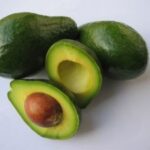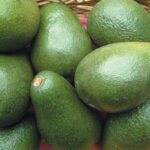Avocados weren’t always the highly esteemed fruit they are today. In fact, it may have been the avocado’s name that led to some misconceptions and scandalous perceptions about the fruit. In the Nahutal language, the language the Aztecs spoke, the name for avocado is āhuacatl, which translates directly to testicle. It’s bad enough that the fruit was named after a certain part of male anatomy, but it was also a powerful symbol of fertility to the Aztecs, who, according to lore, would lock their virgin daughters inside their houses during the harvesting season. When the Conquistadors and Colonists got a load of that you can believe they were frightened. Misconceptions were so extreme that anyone who ate an avocado would find it very difficult to maintain their chaste image. In the 1920s are large ad campaign was launched to dispel perceptions about the aphrodisiac effects of the fruit.
Conquistadors
The first written accounts of the avocado come from the Spanish Conquistadors. In 1518 Martin Fernandez de Enciso was the first to describe the avocado to the old world. Written accounts also exist from Hernando Cortez and Fernandez de Oviedo. Oviedo described the fruits he encountered in Columbia.
“In the center of the fruit is a seed like a peeled chestnut. And between this and the rind is the part which is eaten, which is abundant, and is a paste similar to butter and of very good taste.”
In 1550 Conquistador Pedro de Cieza de Leon was the first to publish the name “Aguacate” as the Spanish corruption to the unpronounceable āhuacatl.
In 1672 Royal physician W. Hughes wrote of the avocado during a visit to Jamaica,
“One of the most rare and pleasant fruits of the island. It nourisheth and strengtheneth the body, corroborating the spirits and procuring lust exceedingly.”
Sir Hans Sloane, the inventor of hot chocolate, was the first person to use the English word “avocado” in his catalog of Jamaican plants published in 1696. The colonists also found new uses for the avocado, including using the red-pigment from crushed pits as ink. Documents written in the brownish-red avocado ink still exist today.
From Caves and Giant Elephants
Archaeological evidence of avocados has been found in caves in the Tehuacán area of South-Central Mexico dating to 7,000 B.C. Evidence in the caves showed a gradual increase in the size of the avocado seeds. Research shows avocados were planted and cultivated stream-side beginning some time around 6,500 B.C. The increased fruit size from selective cultivation was slowed by the long-life of the avocado trees and the presence of many smaller fruited trees, but it was nonetheless effective by 900 B.C. Archaeological evidence also shown that the people in nearby Oaxaca did not engage in the same crop improving methods.
Avocado pits were also found at burial sites. The fruits would have been presents for the dead to maintain fertility in the after life.
Scientists have hypothesized that the avocado may have evolved alongside giant mammals that are now extinct. Giant Ground Sloths or Gomphotheres, large elephant-like mammals that roamed North and South America, may have eaten the fruits, passing the seeds through their digestive systems intact.
Avocado Persea Americana belongs in the family Lauraceae, which includes sassafras, spicebush, and bay leaves. There are three strains of avocados, Mexican, West Indian and Guatemalan. The Mexican strain, which evolved in tropical highlands is the most cold hardy, surviving temperatures below 20F at maturity. The Foliage of the Mexican strain is reported to have an Anise scent that the others do not. Their fruits also have the highest percentage of oil. Fruit from the West Indian strain have lower percentages of oil and they are the most sensitive to cold. The third group is the Guatemalan Avocado which ripens in the winter, 9 to 14 months after flowering. Avocados from the Mexican strain and the West Indian strain are fast maturing, taking approximately 6 to 8 months to go from flower to fruit. Because of the differing seasons inter-strain hybrids became very import for bridging the gap in the seasonal market. The famous Fuerte cultivar is a naturally occurring cross between Mexican and Guatemalan avocado strains.
Avocados are the perfect example of dichogamic protogyny, which is a fancy way of saying the male and female parts of the flower open at different times. The female flowers opening first, closing, and then reopening the next day as male flowers. Avocados are harvested before they are ripe because there is a compound in the stem that prevents the fruit from ripening on the tree. In nature, avocados would fall off of the tree and ripen on the ground, often bruising and affecting the quality of the fruit in the fall. In commercial avocado groves the avocados are picked when they are still green and ripened synthetically using ethylene gas, (the same effect as ripening tomatoes with an apple in a paper bag.) Avocados are harvested using long poles with a v-shaped attachment, the avocado then falls into a cloth sack at the top of the pole to avoid damaging the fruit. Workers in the groves also wear gloves to avoid cutting the skin with their fingernails.
As a fruit, avocados have many good properties. They are rich in healthy fats that are proven to reduce bad cholesterol and raise good cholesterol with regular consumption. On a seven day diet LDL was lowered 22% and HDL was increased 11%. Avocados also have the highest fiber content of any fruit, approximately 6.7g per 100g serving. The fiber consists of 75% insoluble fiber and 25% soluble fiber. Avocados were touted by health fanatic John Harvey Kellogg (brother of Kellogg Cereal founder W.K. Kellogg) for their health giving benefits in his book, New Diectics, what to Eat and how.
The Hass Avodaco
The story of the Hass Avocado, the modern incarnation of this scandalous fruit, is perhaps even more incredible than the avocado’s early history. In 1925, after seeing photos of an avocado tree with dollar bills tied to it, Rudolph Hass a Californian mail carrier with no horticultural background purchased a number of avocado seeds from the, eccentric A.R. Rideout. Rideout scavenged avocado seeds, often from garbage cans, and sold them along with avocado plants. Hass was unable to afford seedlings on his 25 cent per hour salary, so he purchased seeds to plant in his small 1 1/2 acre grove, which already contained a few Fuerte avocado trees. He was instructed by Rideout to plant three seeds per hole, selecting the strongest ones to be the rootstock for grafts of Fuerte trees. Hass hired a professional to graft his trees. After the first attempt all but three of the tree accepted the grafts. The trees were regrafted but again there was one that would not accept the graft. The man advised Hass to let the tree grow because it looked strong and healthy. Ten years after planting his grove, Hass obtained the first patent on a tree for his Hass avocado and gained a following of local buyers who would only purchase Hass’ avocados. Hass only made $5,000 from the patent because buyers would purchase one plants and then make their own cuttings from it once it was mature. Hass had heart problems that prevented him the enlisting in the Army, he prayed that he would live until the expiration of his patent. He died only several months after the expiration of his 17 year patent. His wife lived in their home for many years after, eating an avocado a day from the trees in their backyard. The original Hass avocado tree was cut down in 2002, at age 76, after a long battle with root rot. Today as much as 80% of avocados grown in the U.S. are the Hass Cultivar.
Latex Fruit Allergy
Avocados are delicious anyway you choose to eat them, guacamole, Monterey burgers, or even on their own. Unfortunately some people are allergic of avocados. Our furry friends are also vulnerable to Persin, a fungus-inhibiting toxin in avocados that can harm pets if consumed in large quantities. People can also be allergic to this substance, but latex fruit allergy is more common.
Latex fruit allergy is triggered by the protein enzyme chitinase. In sensitive people it creates an allergic response by releasing histamine. For people many people symptoms set-in immediately after ingestion or up to one hour after ingestion as the body begins digesting the proteins. Symptoms include severe stomach pain, nausea, skin irritation, breathing problems, and in the worst cases, anaphylactic shock. The ripening process, using ethylene gas, also increases the quantity of chitinase in the fruit, possibly increasing the chances for an allergic reaction. Other fruits that can cause the same type of allergic reaction are bananas, mangoes, papayas, and chestnuts. Melons and tomatoes are also suspected. It’s also common to hear of people developing a reaction after increased consumption of certain fruits, for instance it’s possible for a person to become violently ill after eating one or more fruits for a number of consecutive days. The good news is if you are allergic it is usually abundantly clear and does not require a diagnosis to confirm.
John Harvey Kellogg “The New dietetics, what to eat and how” Google Books.
Perdue University “Hort 403 Lecture 33” Perdue University Agriculture: Horticulture Landscape Architecture.
C. Earle Smith Jr., “Additional notes on Pre-Conquest avocados in Mexico ” SpringerLink.
C. Earle Smith Jr., “Archeological evidence for selection in avocado” SpringerLink.
Wikipedia “Hass Avocado – Wikipedia” Wikipedia.
Japan’s NIHS/DMD “Latex-Fruit Syndrome and Class 2 Food Allergy” National Institute of Health Services and Division of Medical Devices.





